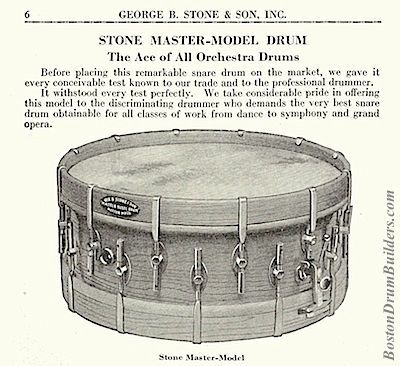A website devoted to Boston's early 20th century drum makers
George B. Stone & Son
Company History • Catalogs • Badges and Labels • Examples • blog
From George B. Stone and Son Catalog G, circa 1912:
"In the [18]80's George B. Stone commenced making drums for his pupils with such success that in 1890 he established a small work shop near his home in Roxbury [MA]. In the course of a year he removed to a larger room in the building we now occupy, where, seeing the possibilities in manufacturing a line of goods so well known to him, he installed machinery and hired an assistant. Hardly had he settled before he had outgrown his new quarters, so he added more floor space, machinery and help, and entered upon selling his drums by mail.
The mail-order business was a decided success and exceeded his most sanguine expectations. Every sale brought new customers, and in spite of his constantly increasing facilities he found it difficult to keep abreast of his orders.
At this time he decided he needed his son, who had completed his third year on the road with one of the best concert and dance orchestras in the New England States. Beginning at the bottom, George L. [Stone] went to work at the bench gaining practical knowledge of drum and trap construction in its every detail. After taking a private course in a Business College in book-keeping and stenography he attended to the office work, and later, being admitted as a partner, took entire charge of the correspondence, with the aid of office assistants."
George Burt Stone died of pneumonia in January of 1917 at the age of 60 leaving the company to his son. George Lawrence Stone's qualifications to assume both the business and his fathers responsibilities as a magazine columnist were described at length in the March 1917 issue of Jacobs' Orchestra Monthly and reprinted in George B. Stone & Son Catalog "I" published in 1919:
"One of the great equalizing laws of nature is that of compensation, which ever seeks to balance loss with some measure of consequent gain. It thus becomes a pleasure deeply tinged with sadness to introduce Mr. George Lawrence Stone, who has assumed his late father's position on the staff of JACOBS' ORCHESTRA MONTHLY.
There is no question as to the competence of Mr. Stone to successfully carry on the work and business begun by his father, nor the shadow of a doubt as to his proving a most worthy successor of an ever reliable department conductor. Already he possesses the broad knowledge and requisites of the father, partly gained through association and example, yet wholly acquired by personal energy and application.
Young Mr. Stone entered the musical field in 1901, and soon was in demand by the best concert and dance teams. In 1907 as tympanist and bell soloist, he joined the Boston Festival Orchestra under the direction of Mr. Emil Mollenhauer. He next became connected with Stewart's big Boston band, and later enlisted in the First Corps Cadets, Massachusetts Volunteer Militia, ranking as regimental drummer. With the advent of the Boston Opera Company he relinquished all playing connections save that with the Boston Festival Orchestra, a position which he held with credit during the entire five years of this company's operatic regime in Boston.
Not withstanding the confining and exacting duties of rehearsals and performances with an established opera company, he had found time, in the interim, to specialize in the study, practice, and teaching of the xylophone, and at the final closing of the opera he entered the vaudeville field as a xylophone soloist, covering the various smaller time theaters throughout the Eastern States. His pronounced success in this field soon attracted the attention of one of the managers of the Keith Theater interests, and he soon was booked in the "big time" on the Keith circuit.
It was during this period of Mr. Stone's public career that Thomas B. Senia, a veteran Boston Drummer, through ill health was obliged to resign his position in the Boston Symphony Orchestra, and through the strong recommendations of several prominent Boston musicians, Mr. Stone was sent for by the director of the Symphony, who first tested his musical ability and then proffered him a three-year contract with the big Boston Orchestra.
Although reluctant to lost the opportunity of being identified with what is probably one of the greatest orchestras in the world, the young tympanist was forced to refuse this offer, as well as another most flattering year's contract for the Keith circuit, tendered by the New York manager. These refusals were wholly contingent upon the rapid growth of the manufacturing business established by his father, and its steadily increasing demands upon his time.
Since 1914, and to the exclusion of outside playing, Mr. George Lawrence Stone has devoted his entire time and energies to the business, the father gradually shifting the executive end to the son, and himself solely to a large class of pupils and the conducting of his magazine department. Of late, however, the younger man had also been largely collaborating with his father in conducting "The Drummer" therefore the touch of his hand will not be entirely new to the readers and correspondents of this department. - The Editor."

Under the direction of George Lawrence Stone, George B. Stone & Son Inc. prospered becoming the largest and most prominent drum manufacturer in New England. The company's manufacturing efforts seem to have peaked in the mid 1920s with the firm employing no fewer than 23 men. During the tenure of advertising manager F . W . Neptune, formerly of J. C. Deagan Inc., the Stone company displayed their largest and most comprehensive offering in Catalog K, published in 1925.
By the mid 1930s, the Great Depression was in full force and the advent of talking movies had put an entire genre of drummers out of work. And as industrialization passed the company by, the Stone Drum and Xylophone School, an integral part of the family business from the very beginning, became the more predominant segment of their business.
Christine Merrick Ayars' Contributions to the Art of Music in America by the Music Industries of Boston 1640 - 1936 (New York: H.W. Wilson, 1937) describes the offerings of the George B. Stone & Son Inc. in 1936 as follows:
"This firm makes all types of drums, except metal shell, mostly single tension. During the World War [I] period the company's entire output was taken by the government under a contract for military drums.
They also manufacture accessories such as drum heads, covers, cases and bags, and specialize in hand-turned sticks, being one of the few manufacturers to make these.
This concern also sells drums and accessories and all the instruments of a percussionist outfit, singly and in combination at wholesale and retail, and outfits bands, largely school bands and American Legion drum corps at present.
A few years ago they brought out a "Mastercraft Drum" which is a patented innovation. There are two pivots inside the shell to loosen or tighten the rods, which go instead of outside, thus eliminating some of the wear on the drum heads. The basis of the patent is the ventilation allowing moisture to come out. The Marlborough, Massachusetts, American Legion band with this kind of drum won the ninth prize offered at the Detroit Convention.
Mail order and retail repairing, rebuilding and replacing of all kinds of percussion instruments, and tuning xylophones constitute an important department of the business. "
By the 1940s, Stone's manufacturing business had faded almost completely and the drum building machinery sat unused for a number of years until is was sold to Ralph Eames, a former Stone student, in 1950. Eames used the equipment mostly to build reproduction Revolutionary War styled rope drums until the company was sold to Joe MacSweeney in 1978. Today the Eames Drum Company continues to build hand crafted birch drum shells using the same equipment used by the Stone company in the early 20th century.
CATALOGS
The George B. Stone & Son company published catalogs featuring their complete line of drums and accessories on a semi-regular basis through at least the mid to late 1920s. New full length publications did not appear each year although updated price lists were released intermittently. Four Stone catalogs are pictured and described below:
Catalog "G", dating roughly from 1912, lists 78 pages of instruments and accessories - an extensive array of products for its time. The publication begins with portraits of George B. Stone and his George Lawrence Stone. The photos are accompanied by brief professional biographies of father and son which mention that the elder Stone now "devotes his entire time to his drum business and pupils", and that the younger Stone has been a member of the Boston Opera Company Orchestra for the 1909 - 1910 and 1910 - 1911 seasons.
The "Stone Special" Thumbscrew Rod Drums are the featured snare drum offering in Catalog "G". The "Stone Separate Straining Rod Drums" are introduced on page 12, illustrated using an early single post tube lug design. A total of nine snare drum models are listed, several of which appear to be from other makers including the "Veneer Shell Drums" and "Metal Shell Drums".
"The Stone Pedal", a wooden bass drum pedal with optional adjustable cymbal arm, is described as having been manufactured by George B. Stone since 1890 and appears on page 29. The Ludwig Drum and Cymbal Beater, patented in 1909, is the only other pedal included and appears 14 pages later.
Catalog "G" also included a modest assortment of keyboard instruments consisting of steel bells, aluminum bells, a professional xylophone, and chimes. All instruments appear to be made in house and are tuned to A=435, the international standard at that time. Twenty-one different drumstick models were included and were available in six varieties of wood - "Hickory, Rosewood, Coco-bolo, Ebony, Genadilla, and Leopardwood (snakewood)". The remainder of the catalog is taken up by an immense assortment of small instruments, traps, sound effects, and accessories.
Catalog "H" was released in roughly 1915 and totaled 78 pages. The Stone Separate Tension drum is now prominently featured and is the first snare drum listed in the catalog. The smaller sizes within the Separate Tension models utilized a single post tube lug design while the two largest sizes, 8" x 15" and 10" x 16", utilized two post tube lugs.
The Stone Thumbscrew Models are listed next, followed by the Veneer Drums which the catalog states are bought from another manufacturer and are "not up to the Stone quality". The vast majority of Stone drums built at this time featured single ply, solid rock maple shells, though solid walnut or mahogany shells were available at an additional cost.
An expanded offering of keyboard instruments are also offered in Catalog "H" as are timpani, cymbals, and a plethora of small instruments, traps, and accessories. A streamlined selection of twelve models of snare drum sticks are offered in four different varieties of wood. Also offered is the option to have "sticks turned exactly to your model or design." Customers are encouraged to send in their old sticks as a sample for this service.
The "Ludwig Drum and Cymbal Beater" is now the first bass drum pedal catalogued followed by "The Stone Pedal" and the "Improved Overhead Pedal" both of which are constructed of wood and were likely built in house by Stone.
Catalog "I" was published in 1919 and spans 68 pages in length. The catalog begins by reprinting an article from the March 1917 issue of Jacobs' Orchestra Monthly which briefly chronicles the death of George B. Stone and then describes the qualifications of his son, George L. Stone, to assume his father's role as head of George B. Stone & Son and also as the percussion columnist for the Jacobs Band and Orchestra publications.
The Stone Separate Tension Orchestra Drum remains the featured snare drum offering in Catalog "I". Introduced for the first time is the "Separate Tension Bass Drum", all previous bass drum models having been single tension. Single tension snare drums are now pictured with stamped metal claws which replace the earlier, more primitive threaded brass versions.
The William F. McIntosh snare strainer and muffler, catalogued as the "Stone Patent Snare Strainer and Muffler", was patented in 1909 and was installed on Stone's higher end offerings from the time of its introduction all the way through the early 1930s. The only notable exception was the strainer used on the Master-Model drums which used an inverted, more elongated version of the same design. Though relatively simple in design, the McIntosh Strainer was a true snare throw-off capable of fully releasing the snares from the bottom head.
The "Victory Model" drums replace the veneer drums as Stone's more economical line. And rather than the McIntosh strainer, the Victory Model snare drums at this time utilized a simpler, more traditional "long model snare strainer" which was not a true throw-off. Catalog I lists the Victory Models in twelve sizes under the headings "Boy Scout, Orchestra, Band, and Bass Drum" and are described as a "line of medium grade drums, which, although not up to the Stone quality, are good serviceable instruments".
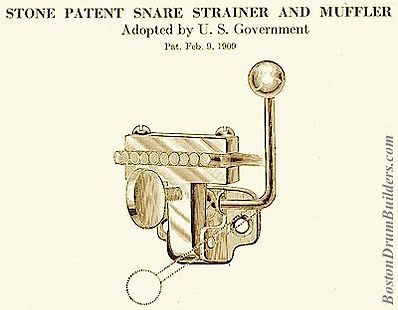
The Victory Models models appear to have been made in house and featured "solid maple shells" and "ebonized counter hoops". The shallow depth Orchestra Models are pictured as being tensioned using thumbscrew rods while the larger Band and Bass Drum models were tensioned using rope and leather ears. The three examples pictures all lack the hoop mounted badge typically used by Stone.
The Ludwig Drum and Cymbal Beater is still the premier bass drum pedal catalogued. The Stone Pedal, "Fly-Weight Overhead Pedal", and "McIntosh Overhead Pedal" are listed together on a subsequent page.
Two styles of Stone bells and three different xylophone models are included in the 1919 catalog as are the previously listed cathedral chimes and timpani. The drumstick pages in Catalog I are reprinted verbatim from the previous catalog. More than 35 pages are devoted to small instruments, traps, parts, and accessories.
Catalog "K", published in 1925 and spanning 63 pages, featured George B. Stone & Son's largest and most complete offering of percussion instruments to date. The Stone Master-Model Drum is now prominently listed as the company's premier snare drum offering. The Separate Tension Snare Drum was still included but now took a back seat to the Master-Model.
Two full pages are devoted to the Master-Model which is pictured in both natural and black finishes and listed in only the 5" x 14" size. Eleven snare drum models are included in Catalog K and all but the "Metal Shell Drum" appear to be built in house.
Complete drumsets are now offered in eight configurations. The most elaborate kit catalogued was the "Stone De Luxe Stage Outfit" and consisted of a 5" x 14" Master-Model Snare Drum and 12" x 26" single tension bass drum with covers for each, a snare drum stand, bass drum pedal and spurs, a 13" cymbal with suspension holder, a chinese tom-tom, a woodblock and cowbell with trap holder, a snare drum mounted cymbal holder, as well as a tambourine, a slapstick, a pair of brushes and a pair of sticks.
The Victory model line of drums are listed now in five sizes under the headings of the "Victory Orchestra Drum" and the "Victory Band Drum".
Victory model bass drums are also offered in five sizes. All Victory model drums are now pictured in a natural maple finish with natural maple hoops, and as single tension thumbscrew drums though rope tension versions were also available. Unlike in Catalog I, the Victory models now feature the Stone / McIntosh snare strainer. Catalog K still illustrates the Victory models without the hoop mounted Stone & Son badge. The Victory model shells are now described only as being "made with good substantial maple", but not specifically single ply. It is even possible that these shells were bought from an outside source.
The "Stone Trap-Door Bass Drum" now appears along with the Separate Tension Bass Drum, several single tension snare drum models, and the Stone Military Bass Drum which was a double strung rope drum with leather ears.
The Stone Orchestra Bells are still listed, but Deagan Xylophones and Xylorimbas now replace the previously catalogued Stone built wooden keyboard instruments. Six different Deagan models are pictured including the Artist Special Xylophone with most instruments offered in a variety of ranges.
The 'Stone Lite-Weight Bass Drum Pedal', which is of metal construction, is the first bass drum pedal pictured and is touted as "the easiest working bass drum pedal ever invented". Metal bass drum pedals by Ludwig and Fraser are listed on the following page. No wooden bass drum pedals remain. A full line of small instruments, traps, parts and accessories was available as was an expanded selection of music including method books and xylophone solos.
"Geldard's Tru-Balance Drum Stix" are now included and were offered in four weights and a choice of either maple or rosewood. The same twelve models of "Stone Master-Model Drum Sticks" appear as in Catalog I and were listed as being available in either rosewood or hickory.
BADGES and LABELS

The first of two versions of the most commonly seen George B. Stone & Son badge used on a wide variety of drums and other instruments dating from the early - mid 1910s and into the early 1920s. This badge last appears in 1922.

A later version of the previous badge. George B. Stone & Son was incorporated in 1920 and instruments bearing badges with the added "INC" lettering began appearing by the Fall of 1922 and continued into the 1930s.

A much less common silver version of the above badge. This particular example appears on an early Master-Model snare drum dating from 1923.

The badge normally used on Master-Model snare drums beginning by January of 1924 and continuing into the 1930s. It also appears on a handful of other drums dating from the mid-late 1930s as the remaining stock of badges was being used.

A silver version of the Master-Model badge was applied to All-Metal Master-Models and most pearl wrapped Master-Models.
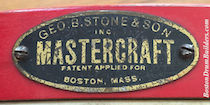
This badge was used on Geo. B. Stone & Son's short lived Mastercraft line of drums dating from the early - mid 1930s.

Scarcely seen, this is possibly the the last badge used on George B. Stone & Son drums, dating roughly from the late 1930s.

A small adhesive decal applied to the exterior of some shells dating from very late in the Stone Company's production. Stone drums from this era are typically very simple in construction, often assembled from mostly generic hardware.
Source: ebay (click to enlarge)

A very early Stone drum label dating from around the turn of the 20th century prior to George Lawrence Stone joining his father's business after which the company was renamed 'George B. Stone & Son'.

A small paper label dated March 1912 applied to the inside of an early Stone & Son drum, trimmed to fit in between the reinforcing rings of a very shallow shell.

A paper label dating from the early - mid 1910s which has been trimmed down to fit on the reinforcing ring of a shallow snare drum. This label also appears in a larger, date-stamped version.
Source: ebay
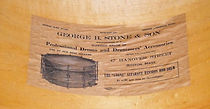
For a period of time in the mid - late 1910s Stone applied a very large label to the inside of deeper shells touting their new Separate Tension Drums.
Source: ebay (click to enlarge)

This paper label appears on drums from the very late 1910s and early 1920s, and begins appearing again in the early - mid 1930s as the company was using up their old stocks of badges, parts, and labels. The later occurrences are sometimes stamped with a four digit serial number in the low - mid 9000 range.

Paper label appearing on a drum dating from circa 1921. This was likely the last small shell label used before Stone standardized their labels beginning in 1922.

This label appears on most Stone drums dating from 1922 through the early 1930s. Typically each label is stamped with a four digit serial number. Serial numbers in the low 5000 range were appearing in 1922 and extend up to around 9000 by the early 1930s. Examples from about 1922 through 1926 commonly are date stamped.
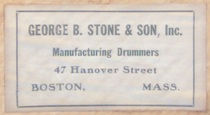
Appears on drums dating from the mid 1930s. Some examples are stamped with a four digit serial number in the mid 9000 range. Others have the address amended to include the 61 Hanover Street office. Both addresses were used concurrently beginning in late 1922 so it is not possible to date Stone instruments using only the street number listed on labels.

A repair label, possibly a much older one, that was repurposed as a makers label for a drum produced ca. 1936.
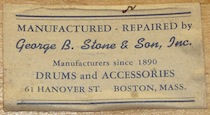
A mid - late 1930s paper label applied to the inside of drum shells. The wording also indicates that this could be used as a repair label.
EXAMPLES

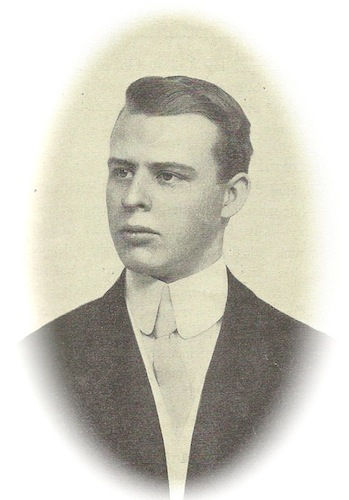
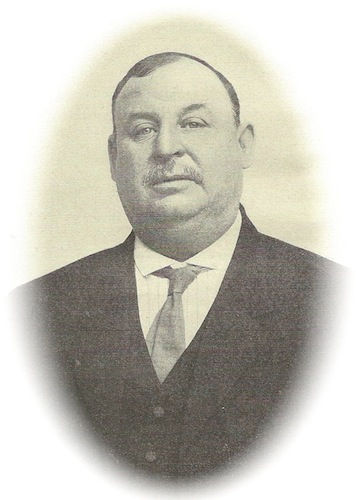
George Burt Stone
1856 - 1917
George Lawrence Stone
1886 - 1967



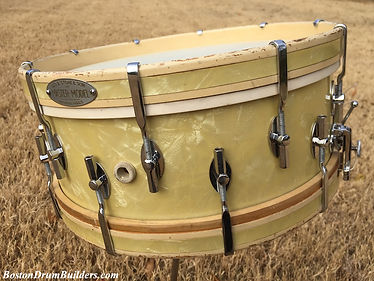
"Master-Model Drum"
First introduced in 1922, the Master-Model Drum was the Stone Company's premier snare drum offering and remains the most recognizable and iconic instrument produced by the company. Originally marketed as the "All-Weather Drum", the name "Master-Model" was adopted by late 1922. The Master-Model snare drums were built from 5" x 14" staggered three-ply all maple shells, not single-ply maple as is sometimes reported. Hoops were constructed of solid maple and were matched specifically to each drum.
Master-Model snare drums were offered in a variety of finishes but the most common by far was what Stone described as "Black De Luxe Finish" with "Nickel Trimmings". Hardware was also available in "Nobby Gold finish" at an additional charge. Natural maple is the second most commonly seen finish on Master-Model snare drums with "White De Luxe Finish" being less common. Examples in wrapped finishes including marine pearl, silver sparkle, and red sparkle were also produced but are not common. An All-Metal Master-Model, built around a solid aluminum shell with matching hoops, was introduced in 1925.
The earliest generation of Master-Model drums featured highly polished rosewood grommets. At some time in 1924 the company began using threaded black synthetic grommets instead. The first Master-Models employed cylindrical tension nuts. A second generation appeared soon after which was partially hexagonal and partly cylindrical. The most commonly seen tension nuts were completely hexagonal and could easily be tuned with a wrench.
The Master-Model snare drums were produced through the mid 1930s with more than 800 drums ultimately being built.

"Stone Special" Thumbscrew Rod Drum
The paper label inside of this drum is stamped MAR 1912 dating the instrument to well before the company's prime. Of special interest here is the extremely shallow shell depth which measures only two inches. The rosewood grommet is cleverly recessed into the shell to prevent it from obstructing the flesh hoops should the heads be tensioned down tightly enough. An early version of the McIntosh strainer is stamped with the inventor's name rather than the Stone brand as appears commonly on later examples.

Master-Model Field Drum
This drum is a fairly simple single tension field drum but oddly features a Stone Master-Model badge. No such drum is mentioned in Stone catalogs up through 1925. The number 9440 is stamped in the shell which dates this drum to the mid 1930s which was fairly late in the company's drum building life. While it is possible that such a drum could have been cataloged near the end of Stone's run, it is more likely that the company had run out of Stone badges by this time and was simply using up the remaining stock of Master-Model badges. By the late 9000 serial number range and towards the very end of Stone's production, decals were applied to the outside of shells and no badge was used.


The Stone Separate Tension Drum
The Stone Separate Tension Drums were produced from the early 1910s through at least the late 1920s. For many years, until the introduction of the Master-Model in 1922, the Separate Tension Drums were Stone's premier snare drum offering.
The Separate Tension Drums were catalogued in a wide range of sizes from 'Orchestra' models as small as 3" x 14" to 'Band' models as large as 17" x 12". Orchestra models used a single post tube lug while the larger Band models featured a more conventional two post tube lug design. Stone typically installed a single washer between each tube lug post and the shell. There was at least one earlier style of tube lugs used before the more commonly seen design began use in the mid 1910s and continued through the 1920s. Tube lugs varied in length depending on the size of the drum.
Until about 1922, the Stone Separate Tension Drums were built from single ply shells, most commonly maple, with three or four reinforcing rings depending on the shell depth and number of tube lug posts. Around 1922 or 1923 the orchestra sizes began employing three-ply, 5/8" thick shells like those used for the Master-Model drums. The larger Orchestra models and other drums made in house retained their one-ply shells with solid maple reinforcing rings.
All Stone drums produced in house incorporated single ply maple counter hoops. Drums built up until 1924 featured wooden grommets. Beginning sometime in 1924 Stone began installing black synthetic grommets made from a material sometimes referred to as 'bakelite'. These synthetic grommets which simply screwed into a large threaded vent hole often cracked or go missing altogether from surviving examples.
The patented McIntosh Strainer, catalogued by Stone as the "Stone Patent Snare Strainer and Muffler", was standard on the Separate Tension models as well as Stone's other higher end snare drums. Earlier versions of the throw-off were stamped "McINTOSH" while later versions were stamped "STONE" and "PAT. FEB 9, 1909".
Single Tension Field Drum
Stone sold a great number of single tension drums in a wide range of sizes. Early on in the company's existence, up through the early 1910s, single tension drums were offered as high end, professional models. Stone's separate tension models moved ahead of their single tension drums by the mid 1910s after which the single tension snare drums were intended to be more economical, lower level products.
This drum dates from the mid - late 1930s, very near the end of the company's drum building days. By this time the industry had all but passed Stone by as the company never truly modernized their designs or production methods. And as the advent of talking movies and the Great Depression combined to put a huge segment of drummers out of work, there was less business for Stone and other musical instrument manufacturers. George Lawrence Stone would come to rely more on teaching than on musical instrument production and retailing as the drum making business was allowed to fade out completely by the early 1940s.
The last drums produced by Stone were simple in construction being pieced together with remaining old stock and mostly generic parts. The shell and strainer on this drum are still marked with the Stone name but there is no badge. Instead, a small gold and black decal listing the 61 Hanover Street address is applied to the exterior of the shell.
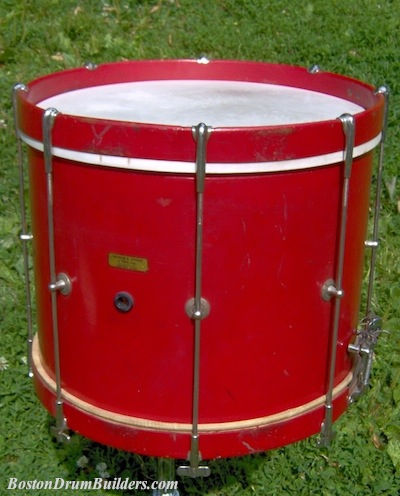

George B. Stone & Son
Catalog K - ca. 1925
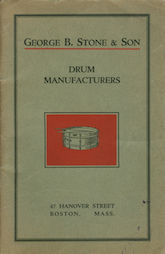
George B. Stone & Son
Catalog I - ca. 1919

George B. Stone & Son
Catalog H - ca. 1915

George B. Stone & Son
Catalog G - ca. 1912

George B. Stone & Son
Catalog G - ca. 1912

George B. Stone & Son
Catalog H - ca. 1915
